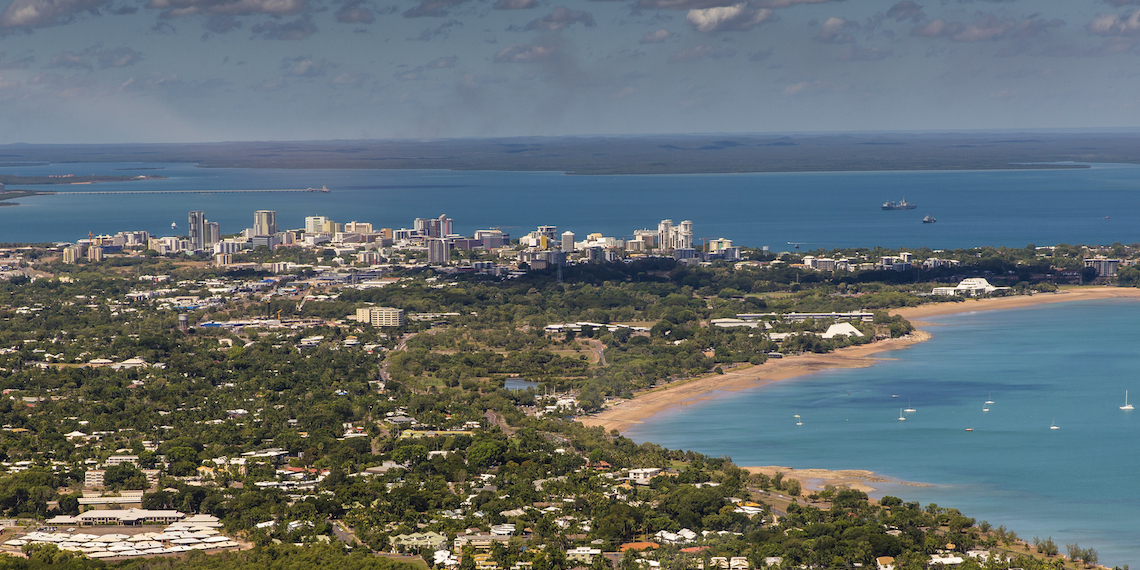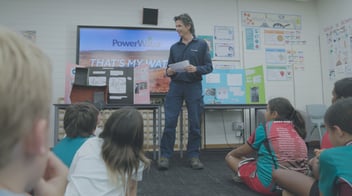The decades-long journey behind ensuring Darwin’s water security

The Power and Water Corporation and Northern Territory Government are committed to providing safe and secure drinking water for all Territorians, now and into the future. A clear vision has been identified, that the Northern Territory will need to augment its water supply to meet future demand and economic growth objectives.
Delivering a strategy to provide that additional water supply has been a main priority for Power and Water’s planning and design team for the past 10 years. Senior Headworks Planning Engineer, Trevor Durling, has been driving the project from its inception, with the project expected to take a further 10 years to be delivered.
Power and Water and the Northern Territory Government engaged PricewaterhouseCoopers to develop a detailed business case, which assessed a range of options to increase water supply in the Darwin region. The business case was released to the public in May 2022.
This comprehensive assessment identified the Darwin Region Water Supply Infrastructure Program, which includes Manton Dam Return to Service (RTS) and the Adelaide River Off-stream Water Storage (AROWS) projects, as the best solution to meet the short and long-term water needs of the Territory.
Stage 1 of the Darwin Region Water Supply Infrastructure Program is jointly funded through the Australian Government’s National Water Grid Fund ($300.6 million) and the Northern Territory Government ($23.5 million).
The long-term solution for Darwin’s water security is the Adelaide River Off-stream Water Storage – or AROWS – project. While the plan is conceptually ingenious, it has involved considerable effort from Power and Water and the Northern Territory Government to ensure its viability for the Darwin region.
Durling will discuss the journey Power and Water has undertaken in proving the project’s feasibility in a presentation at Ozwater’23 in May, titled ‘The Adelaide River Off-stream Water Storage project: Turning a bright idea into an investment-ready project’.
“My role at Power and Water is to make sure that Darwin never, ever, ever runs out of water,” Durling said.
“To do that, we have developed the Darwin Region Water Supply Strategy that includes a program of new sources of water to be developed and connected into the system over time to enable growth. Through understanding current demand for water and where demand is heading – and then looking at opportunities in both the demand and supply-side management intervention options – the idea is that Darwin has water to grow over time.”
Looking to the future
As part of this strategy, Power and Water also identified returning Manton Dam to service as a short-term solution, with AROWS being identified as the best option to support growth for the future. Combined, these two projects will provide an additional 67 billion litres of water per year into the Darwin water supply system.
“It will be a game-changer for the region in terms of both water security for urban-connected customers, but also enabling water for economic growth. There's a push in the Territory to build to a $40 billion economy by 2030, and to do so, we need a range of things including water,” Durling said.
“AROWS will enable industrial development in Darwin and potentially irrigated agriculture in our region, because the groundwater resource that existing horticulture relies on is over-subscribed.
“If we want to offer an opportunity to grow the horticultural industry in our region, we need to find water elsewhere. AROWS ticks all three boxes in terms of the Darwin region's water needs: water for drinking, water for making and water for growing.”
The project involves extracting water from the Adelaide River into an adjacent basin for storage.
“This water supply option was first discovered when a Power and Water engineer flew over the site in a light aircraft and identified a natural topographic feature on the land that seemed to form the shape of a basin alongside the Adelaide River,” Durling said.
Considering the options
In undertaking the feasibility studies, Power and Water considered the AROWS project across a number of dimensions, assessing engineering and technical requirements, and environmental, social and cultural impacts.
“AROWS stands out as the right option for a range of reasons. A large benefit of the project is that it's less environmentally impactful than an in-stream dam; developing an off-stream storage doesn't restrict the natural flow of any of our major rivers here,” Durling said.
“The project allows us to selectively harvest water from the Adelaide River during the wet season when there's lots of water going down the river.
“And in accordance with extraction rules set by the environmental regulator, we’ll be able to pump water out of the river and into the basin under conditions that maintain the integrity of the ecological and cultural values of the river. So, from an environmental perspective, it's a really attractive option.”
“The AROWS scheme is large enough that it can fulfil Darwin’s forecast water demand through to 2050. It's going to require some significant investment, but it's an investment in the future for the region.”
Investigations and planning
An important step in the feasibility phase involved demonstrating the geological and hydrogeological soundness of the proposed storage to ensure the site is fit for purpose.
“What you don't want is to fill the reservoir with water, have it all seep into the groundwater, and then have that groundwater drain out to the river underneath the ranges that you think are holding it all in,” Durling said.
“Once you've established that the site is sound for holding water, you also need to know how much water is available in the river to extract and transfer into the reservoir. We've developed a hydrological modelling capability here at Power and Water and a comprehensive understanding of the Adelaide River’s hydrology.
“We've worked with the regulator to scenario-test different extraction regimes so as to establish the quantity of water and the rules under which we may be able to take water from the Adelaide River to support the water supply scheme, subject to formal environmental assessment and the development of a Water Allocation Plan.”
Power and Water has also undertaken habitat mapping, threatened species surveys, and greenhouse gas emissions studies, as well as ensuring that the land is available to use from Aboriginal interests and land tenure perspectives.
“You look at land tenure and whether Native Title rights and interests may continue to exist,” Durling said.
“You have to seek a certificate related to Aboriginal sacred sites and make sure that if sacred sites exist, you understand what the controls are around those sites to protect them. You need to look at both European and Indigenous heritage, so you get an archaeological surveyor out there to look for artefacts, and to look for World War II history from a European perspective because there were lots of Defence activities out in the bush around Darwin.
“To date, we haven’t identified any significant barriers to the project and we’ve demonstrated the feasibility of the scheme, so it’s ready for further investment in a formal environmental assessment, further design development and work to secure the land for the project.”
Efforts from Power and Water and the Northern Territory Government thus far have paid off, with the Australian Government committing $300 million through the National Water Grid Fund to advance the first stage of the Darwin Region Water Supply Infrastructure Program, including $18 million to move forward with project development and de-risking for AROWS.
At the end of this phase, the Northern Territory Government will then seek further investment from the Australian Government.
“We're targeting delivering water from AROWS by 2031. So there's quite a process ahead in terms of de-risking, detail design, construction of the various elements of the project, commissioning of the reservoir, the pump stations, the pipeline, the water treatment plant,” Durling said.
“Leveraging funding and maintaining momentum over more than a decade to complete the feasibility phase of the AROWS project has required passion, patience and persistence, but the idea of developing an environmentally sustainable water supply scheme in the north is something that everyone can get behind, and the future for the project is very exciting.”
Following from the work Power and Water have done to assess the viability of the AROWS project for supplying water to the Darwin region, the project has now transitioned into the planning and approvals phase.
This phase, which is being led by the Northern Territory Government, will involve undertaking an Environmental Impact Statement process, project concept design, and stakeholder and community engagement. The planning and approvals phase of AROWS is expected to take about three to four years to complete.
Power and Water will remain involved throughout the project phase as their in-depth knowledge of AROWS is invaluable to project delivery.
Interested in hearing more about the development of the AROWS project? Register for Ozwater’23 here.



